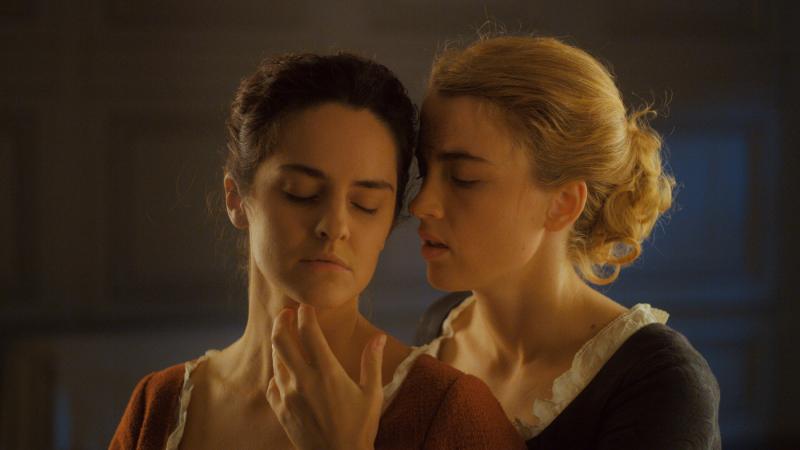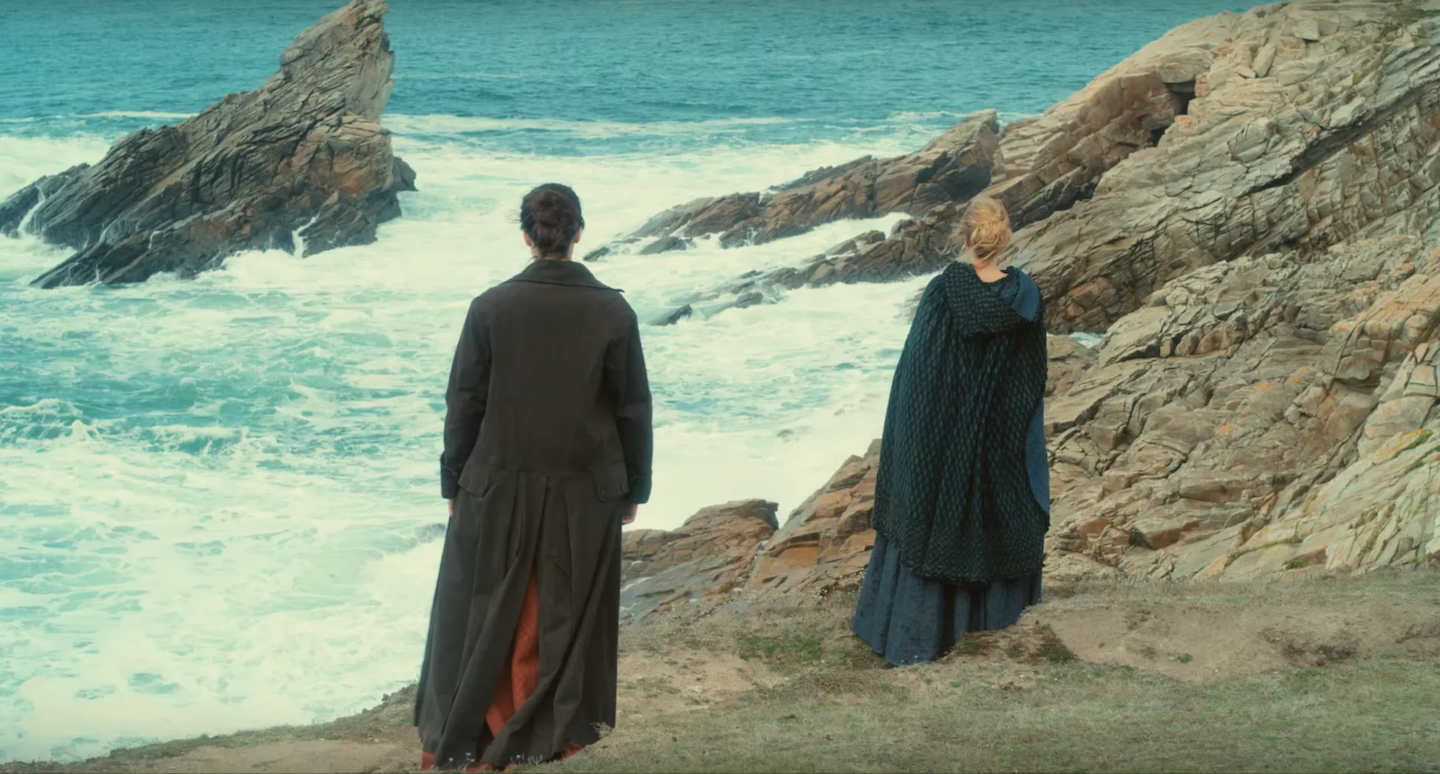Portrait of a Lady on Fire review – love unshackled | reviews, news & interviews
Portrait of a Lady on Fire review – love unshackled
Portrait of a Lady on Fire review – love unshackled
Céline Sciamma's spellbinding costume drama has no room for a Mr. Darcy or Heathcliff

Portrait of a Lady on Fire is windblown, spare, taut, and sensual – a haunted seaside romantic drama, set in the 18th century, that makes most recent films and series dressed in period costumes seem like party-line effusions of empty style and social conservatism (Gentleman Jack excepted).
Writer-director Céline Sciamma’s fiercely adult follow-up to her coming-of-age trilogy – Water Lilies (2007), Tomboy (2011), Girlhood (2014) – can be enjoyed simply as the story of two women falling torturously in love just before one of them enters an arranged marriage in pre-Revolutionary France. In terms of modern sexual politics, it’s a pointed celebration of how some female lovers look, see, understand, empathize and argue with, and touch each other. More than that, it’s a meditation on how images replace memories when they fade or bleed into our personal myths of those we’ve loved and lost.
An art teacher of young Parisian women, Marianne (Noémie Merlant) is troubled when a painting she had made of a lone woman wearing a burning dress in a dark landscape is fetched out of its hiding place and displayed by one of her students. Segueing from life class to life lesson, Marianne recalls how she once travelled to a shuttered stately house on a Breton island to paint the young noblewoman Héloïse (Adèle Haenel). Yearning to return to her Milan hometown, Héloïse’s mother (Valeria Golino) had selfishly commissioned the portrait to showcase her daughter’s beauty to a rich Milanese seeking a wife.
 In the extended flashback, the mother (who had similarly been painted by Marianne's father) brings Héloïse from her convent to sit for Marianne, but she won’t comply. Her older sister has recently killed herself rather than submit to being painted for the suitor’s delectation – that covetous male gaze again. Her unseen suicide casts a Gothic pall on Portrait of a Lady on Fire, though more lightly so than does the first Mrs. de Winter’s death on Alfred Hitchcock’s Rebecca (1940).
In the extended flashback, the mother (who had similarly been painted by Marianne's father) brings Héloïse from her convent to sit for Marianne, but she won’t comply. Her older sister has recently killed herself rather than submit to being painted for the suitor’s delectation – that covetous male gaze again. Her unseen suicide casts a Gothic pall on Portrait of a Lady on Fire, though more lightly so than does the first Mrs. de Winter’s death on Alfred Hitchcock’s Rebecca (1940).
Pretending to be Héloïse’s companion so she can observe and paint her from memory in private, Marianne accompanies her on a walk on the same clifftop from which Héloïse’s sister threw herself. They fall in love at first sight. Once Marianne has confessed her complicity in the mother’s scheme and been forgiven by Héloïse, they move tentatively toward consummation as equals. The navy blues, cobalts, and aquamarines that dominate cinematographer Claire Mathon’s palette early on give way to less frigid colors – the startling emerald of Héloïse’s dress harmonizes with the sumptuous burgundy of Marianne’s as their mutual desire intensifies.
There’s no room for a Mr. Darcy or Heathcliff here. Men are absent between the scene showing oarsmen delivering Marianne to the beach near Héloïse’s home and the scene introducing the courier who has come to collect Marianne’s second Héloîse portrait (she destroyed the first to prolong their time together). The entire middle act is a separatist idyll in which the lovers bond with the quiet housemaid Sophie (Luàna Bajrami, above with Merlant).
Class barriers evaporate: a tableau shot depicts Héloîse preparing food on the left of the frame, Marianne in the center pouring wine into three glasses, and Sophie on the right working on her sampler; a close-up of her flower design, taken from life, reveals that art isn't just a bourgeois pursuit. Marianne and Héloise assist Sophie’s attempts to end her unwanted pregnancy through dubious folk remedies. When these fail, they bring her to a village abortionist, who has Sophie recline on a bed occupied by a baby and a toddler – Héloise, appreciating Sophie’s social defiance, tells Marianne, who relates to the world through art, not to flinch from the spectacle; afterwards Héloise has Marianne paint it to honour Sophie’s stoicism (a quality she shares) and the abortionist’s work.
 Sciamma thus looks beyond Héloise and Marianne’s romantic and physical love to celebrate female companionship and fortitude. In a stirring evening sequence, Marianne and Héloise lock eyes while wandering among village women of different ages who have lit a bonfire on the beach and witchily chant “fugere non possum".
Sciamma thus looks beyond Héloise and Marianne’s romantic and physical love to celebrate female companionship and fortitude. In a stirring evening sequence, Marianne and Héloise lock eyes while wandering among village women of different ages who have lit a bonfire on the beach and witchily chant “fugere non possum".
Meaning “we cannot flee,” the Latin phrase was translated by Sciamma from Nietzsche’s words, “The higher we soar, the smaller we appear to those who cannot fly,’” and it embraces the women’s fatalism and their triumphant sense of self. The flames set light to Héloise’s dress. Marianne extinguishes them, but the fire ignited in both women leads them the following day to a crevice in the rock face abutting the beach. It’s a powerfully symbolic setting for their first kiss.
With the help of its brilliant actresses, Portrait of a Lady on Fire reclaims the gaze from Abdellatif Kechiche’s 2013 Blue Is the Warmest Colour, an explicit lesbian romantic drama notoriously made with men in mind at the cost of its female stars. Prior to their encounter with the women on the beach, Héloise reads to Marianne and Sophie the Roman poet Ovid’s account in Metamorposes of how Orpheus doomed his beloved Eurydice to a second death by illicitly gazing on her when rescuing her from the Underworld.
The tale angers the normally imperturbable Sophie. Marianne argues that Orpheus wanted the memory of Eurydice rather than the woman herself – “He doesn’t make the lover’s choice but the poet’s.” Héloise offers that perhaps Eurydice asked him to look at her. She herself has none of Orpheus’s free will when she asks Marianne to look at her as the film draws to its close, at which point gazing seems less like a gendered endangering act than an eternalizing of transient romantic joy.
The future of Arts Journalism
You can stop theartsdesk.com closing!
We urgently need financing to survive. Our fundraising drive has thus far raised £49,000 but we need to reach £100,000 or we will be forced to close. Please contribute here: https://gofund.me/c3f6033d
And if you can forward this information to anyone who might assist, we’d be grateful.

Subscribe to theartsdesk.com
Thank you for continuing to read our work on theartsdesk.com. For unlimited access to every article in its entirety, including our archive of more than 15,000 pieces, we're asking for £5 per month or £40 per year. We feel it's a very good deal, and hope you do too.
To take a subscription now simply click here.
And if you're looking for that extra gift for a friend or family member, why not treat them to a theartsdesk.com gift subscription?
more Film
 Blu-ray: Le Quai des Brumes
Love twinkles in the gloom of Marcel Carné’s fogbound French poetic realist classic
Blu-ray: Le Quai des Brumes
Love twinkles in the gloom of Marcel Carné’s fogbound French poetic realist classic
 Frankenstein review - the Prometheus of the charnel house
Guillermo del Toro is fitfully inspired, but often lost in long-held ambitions
Frankenstein review - the Prometheus of the charnel house
Guillermo del Toro is fitfully inspired, but often lost in long-held ambitions
 London Film Festival 2025 - a Korean masterclass in black comedy and a Camus classic effectively realised
New films from Park Chan-wook, Gianfranco Rosi, François Ozon, Ildikó Enyedi and more
London Film Festival 2025 - a Korean masterclass in black comedy and a Camus classic effectively realised
New films from Park Chan-wook, Gianfranco Rosi, François Ozon, Ildikó Enyedi and more
 After the Hunt review - muddled #MeToo provocation
Julia Roberts excels despite misfiring drama
After the Hunt review - muddled #MeToo provocation
Julia Roberts excels despite misfiring drama
 Ballad of a Small Player review - Colin Farrell's all in as a gambler down on his luck
Conclave director Edward Berger swaps the Vatican for Asia's sin city
Ballad of a Small Player review - Colin Farrell's all in as a gambler down on his luck
Conclave director Edward Berger swaps the Vatican for Asia's sin city
 London Film Festival 2025 - Bradley Cooper channels John Bishop, the Boss goes to Nebraska, and a French pandemic
... not to mention Kristen Stewart's directing debut and a punchy prison drama
London Film Festival 2025 - Bradley Cooper channels John Bishop, the Boss goes to Nebraska, and a French pandemic
... not to mention Kristen Stewart's directing debut and a punchy prison drama
 London Film Festival 2025 - from paranoia in Brazil and Iran, to light relief in New York and Tuscany
'Jay Kelly' disappoints, 'It Was Just an Accident' doesn't
London Film Festival 2025 - from paranoia in Brazil and Iran, to light relief in New York and Tuscany
'Jay Kelly' disappoints, 'It Was Just an Accident' doesn't
 Iron Ladies review - working-class heroines of the Miners' Strike
Documentary salutes the staunch women who fought Thatcher's pit closures
Iron Ladies review - working-class heroines of the Miners' Strike
Documentary salutes the staunch women who fought Thatcher's pit closures
 Blu-ray: The Man in the White Suit
Ealing Studios' prescient black comedy, as sharp as ever
Blu-ray: The Man in the White Suit
Ealing Studios' prescient black comedy, as sharp as ever
 The Woman in Cabin 10 review - Scandi noir meets Agatha Christie on a superyacht
Reason goes overboard on a seagoing mystery thriller
The Woman in Cabin 10 review - Scandi noir meets Agatha Christie on a superyacht
Reason goes overboard on a seagoing mystery thriller
 London Film Festival 2025 - crime, punishment, pop stars and shrinks
Daniel Craig investigates, Jodie Foster speaks French and Colin Farrell has a gambling habit
London Film Festival 2025 - crime, punishment, pop stars and shrinks
Daniel Craig investigates, Jodie Foster speaks French and Colin Farrell has a gambling habit
 I Swear review - taking stock of Tourette's
A sharp and moving tale of cuss-words and tics
I Swear review - taking stock of Tourette's
A sharp and moving tale of cuss-words and tics

Add comment